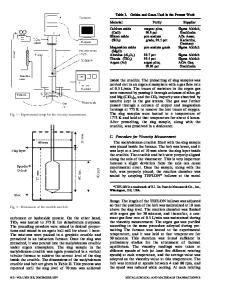Nature of MgO and Al 2 O 3 Dissolution in Metallurgical Slags
- PDF / 869,584 Bytes
- 5 Pages / 593.972 x 792 pts Page_size
- 27 Downloads / 313 Views
THE dissolution of oxides, e.g., MgO and Al2O3, in metallurgical slags plays a key role in metallurgical processing because the service lifetime of refractory primarily depends on its dissolution mechanism. A slow, steady, indirect dissolution, i.e., by forming an intermediate solid reaction product at or near the oxide/slag interface is preferred to prolong the refractory life.[1] In addition, the dissolution of oxide inclusions into slag affects inclusion removal efficiency.[2] A fast dissolution reduces the chance of inclusion entrapment and hence improves the steel cleanliness. Finally, slag, the byproduct of primary metallurgical process, can be valorized by altering its mineralogy and composition.[3,4] This is normally achieved by adding oxide powders into liquid slag. No extra heat is supplied in this process to save the production cost and fast dissolution is normally required.[4] Therefore to guarantee the product quality, maximize the production efficiency and minimize the production cost, a thorough understanding of the nature of oxides dissolution in metallurgical slags is necessary. Traditionally, post-mortem methods like the cold-finger technique—dipping a refractory rod into molten slag—have been used to investigate the oxide dissolution mechanism.[1,5] In the recent decades, in situ observations with the confocal scanning laser microscope (CSLM) have provided direct evidence of oxide PENGCHENG YAN, Researcher, BRYAN A. WEBLER, Assistant Professor, and P. CHRIS PISTORIUS and RICHARD J. FRUEHAN, Professors, are with the Center for Iron and Steelmaking Research, Department of Materials Science and Engineering, Carnegie Mellon University, 5000 Forbes Ave., Pittsburgh, PA 15213. Contact e-mail: [email protected] Manuscript submitted June 17, 2015. METALLURGICAL AND MATERIALS TRANSACTIONS B
dissolution in transparent slags and allow quantitative investigation. Although particle rotation still limits the accuracy of size analysis, researchers have carefully offset the inaccuracy in data analysis and many observations have been made on the dissolution of various oxides in a wide range of slag systems. For instance, Sridhar and Cramb first used CSLM to observe the dissolution of Al2O3 particles with 40 to 70 lm diameter in a CaO (33.4 wt pct)-SiO2 (39.5 wt pct)-Al2O3 (19.7 wt pct)-MgO (7.3 wt pct) slag;[6] they found that Al2O3 dissolution is limited by boundary layer diffusion when the particle diameter is larger than 10 lm, and the particle becomes increasingly transparent and unstable when its size below 10 lm. After their pioneering work, many Al2O3 dissolution tests have been carried out,[2,6–14] and it is generally accepted that Al2O3 dissolution is governed by the mass transfer in slag, i.e., through boundary layer diffusion or bulk slag diffusion. The former refers to the mass transfer limited by a thin boundary layer at the oxide/slag interface and assumes that a concentration gradient only exists within this thin layer. The latter, however, considers the concentration gradient from the interface to bulk slag,
Data Loading...









